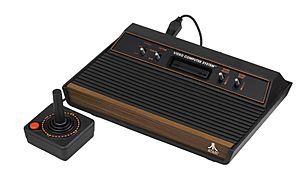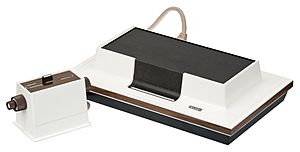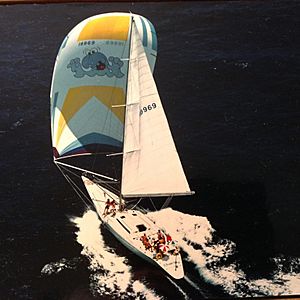Nolan Bushnell facts for kids
Quick facts for kids
Nolan Bushnell
|
|
|---|---|

Bushnell in 2013
|
|
| Born |
Nolan Kay Bushnell
February 5, 1943 Clearfield, Utah, U.S.
|
| Alma mater | University of Utah Stanford Business School |
| Known for | Co-founding Atari, Inc. Pong Creator & founder of Chuck E. Cheese |
| Awards | Video Game Hall of Fame Consumer Electronics Association Hall of Fame |
| Scientific career | |
| Fields | Electrical engineering Computer software |
Nolan Kay Bushnell (born February 5, 1943) is an American businessman and electrical engineer. He is famous for starting Atari, Inc. and the Chuck E. Cheese's Pizza Time Theatre restaurants. He is recognized as one of the people who helped create the video game industry.
Nolan Bushnell has received many honors, including being inducted into the Video Game Hall of Fame and the Consumer Electronics Association Hall of Fame. He also received a special award from BAFTA (British Academy of Film and Television Arts). He has started more than 20 companies throughout his career.
He is known for "Bushnell's Law," which says that the best games are "easy to learn and difficult to master." This idea has been very important in game design.
Contents
Nolan Bushnell's Life and Education
Early Life and School
Nolan Bushnell was born in 1943 in Clearfield, Utah. He grew up in a regular family and went to Davis High School. In 1961, he started studying engineering and business at Utah State University. Later, in 1964, he transferred to the University of Utah, where he earned a degree in electrical engineering.
He married his first wife, Paula Rochelle Nielson, in 1966, and they had two daughters. They moved to California in 1969. After they divorced in 1975, he married Nancy Nino in 1977, and they had six children together.
Learning About Games
While in college, Nolan Bushnell worked at Lagoon Amusement Park. He became the manager of the games department. This job helped him understand how arcade games worked and what made people want to play them. He learned a lot about how to make a game business successful by watching customers and fixing machines. He was especially interested in games where players needed both skill and luck to win prizes.
Starting a Business Career
First Steps and Syzygy
After college, Bushnell moved to California. He wanted to work for Disney, but they usually didn't hire new graduates. Instead, he got a job as an electrical engineer at Ampex. There, he met Ted Dabney, who shared his interest in electronic games. Bushnell showed Dabney a game called Spacewar! at Stanford University.
In 1970, Bushnell and Dabney started their own company called Syzygy. Their goal was to create a game similar to Spacewar! called Computer Space. They worked with Nutting Associates, a company that made coin-operated games, to build the game cabinets.
Computer Space didn't sell as well as they hoped, even though it made over $3 million. Bushnell felt that Nutting Associates didn't market the game well enough. He decided that their next game needed to be simpler so that players wouldn't have to read instructions, making it easier for everyone to enjoy.
Creating Atari, Inc.
In 1972, Bushnell and Dabney started a new company. They found out that the name "Syzygy" was already being used, so they chose the name Atari. This name comes from a term in the game Go, which was Bushnell's favorite game.
They rented their first office in Sunnyvale, California. They hired their second employee, an engineer named Allan Alcorn. Bushnell asked Alcorn to create a simple table tennis game as a test. He told Alcorn it was for General Electric to motivate him. Alcorn added his own ideas, like making the ball speed up during the game, and that's how Pong was created.
Pong became incredibly popular! Atari released many Pong-based arcade video games over the next few years. After Pong's success, Bushnell and Dabney had disagreements, and Bushnell bought Dabney's share of Atari in 1973.
To sell more arcade games and avoid rules about who could distribute them, Bushnell secretly had his neighbor, Joe Keenan, start a company called Kee Games in 1973. Kee Games made similar versions of Atari's games. Even with Kee's help, Atari had trouble keeping up with demand. In 1974, Bushnell decided to merge Kee Games into Atari. This happened just before the release of Tank, a new game from Kee, which became a big success and helped Atari financially.

With Atari doing well, they started making home video game systems. Their first home Pong consoles came out in 1975. Atari continued to make different versions of its arcade games for home consoles until 1977.
Around this time, Steve Jobs and Steve Wozniak, who used to work at Atari, asked Bushnell to invest in their new home computer system, the Apple I. They even offered the design to Atari first, but Bushnell wanted Atari to focus on arcade and home consoles. Later, in 1975, Jobs offered Bushnell a chance to own one-third of their new company, Apple Inc., for $50,000. Bushnell later said he regretted saying no to that offer!
Atari engineers worked on a new, more advanced home console that could play different games using game cartridges. This console was released in 1977 as the Atari Video Computer System, later known as the Atari 2600. However, another company, Fairchild, released the first cartridge-based console before Atari. Bushnell realized they needed to finish the Atari VCS quickly.
Instead of becoming a public company, Bushnell decided to sell Atari. Warner Communications bought Atari for $28 million in November 1976. Bushnell personally received $15 million. Warner invested a lot of money to help finish the Atari VCS, which was released in September 1977.
Sales of the Atari VCS were slow at first. Warner brought in Ray Kassar to help with marketing. Kassar created successful advertising campaigns, and sales improved greatly by the end of 1978, especially with the popularity of Space Invaders. However, Bushnell and Warner Communications realized he was no longer the best leader for the company. He left Atari in early 1979. Before leaving, Bushnell bought back the rights to Pizza Time Theatre from Atari.
Chuck E. Cheese's Pizza Time Theatre
In 1977, while still at Atari, Bushnell bought back Pizza Time Theatre from Warner Communications. He had originally created it as a place where kids could eat pizza and play video games. It was also a way for Atari to sell its games. Chuck E. Cheese's Pizza Time Theatre also featured animatronic animals that played music for entertainment. Bushnell had always wanted to work for Walt Disney, and Chuck E. Cheese was his way of creating a fun, animated entertainment experience.
In 1981, Bushnell focused on other projects, including Sente Technologies and Kadabrascope. Sente was a return to the coin-operated game business, creating arcade cabinets where operators could easily change games. Kadabrascope was an early attempt at computer animation.
By the end of 1983, Chuck E. Cheese was facing serious financial problems. Nolan Bushnell tried to help, but the board of directors did not agree with his ideas. He resigned in February 1984, and Chuck E. Cheese's Pizza Time Theater filed for bankruptcy in March 1984.
Later, in May 1985, a competing restaurant called ShowBiz Pizza Place bought Pizza Time Theatre. The combined company eventually united all locations under the Chuck E. Cheese's Pizza brand by 1993. Today, there are over 560 Chuck E. Cheese's restaurants.
Other Business Ventures
Catalyst Technologies
Bushnell founded Catalyst Technologies, which was one of the first "business incubators." This means it helped new companies get started. Catalyst Group supported many companies, including Androbot, Etak, Cumma, and Axlon.
Axlon successfully launched many products, like the AG Bear, a toy bear that repeated a child's words. Etak, founded in 1984, was the first company to create digital maps for cars. These maps later became the basis for Google Maps and other navigation systems.
Many of Catalyst's ideas were ahead of their time. For example, CinemaVision tried to develop high-definition television, and ByVideo developed an early online shopping experience using kiosks. Most of these companies eventually failed because the technology needed to support them wasn't available yet in the 1980s.
PlayNet/Aristo
After trying to buy Atari Games in 1996, Nolan Bushnell became a consultant for a small game developer called Aristo International. He helped lead TeamNet, which created multiplayer arcade machines for adults. These machines allowed teams of players to compete locally or online. Aristo was later renamed PlayNet. The company faced financial problems and eventually closed in 1997.
uWink
Before BrainRush, Bushnell's company was uWink. This company aimed to create an interactive entertainment restaurant, similar to his Chuck E. Cheese idea. Guests could order food and drinks using touchscreens at their tables. They could also play games with each other and watch videos on these screens.
The first uWink Media Bistro opened in Woodland Hills, California, in October 2006. More locations opened, but all the restaurants have since closed.
Return to Atari SA
On April 19, 2010, Atari SA, the company that owns the Atari brand today, announced that Nolan Bushnell would join its board of directors. This marked his return to Atari after more than 30 years.
Modal VR
Nolan Bushnell is also a founder of Modal VR. This company creates a portable virtual reality (VR) system for businesses. For example, it can be used to train security forces.
Anti-Aging Games, LLC
Nolan Bushnell is on the advisory board and was a co-founder of Anti-AgingGames.com. This company offers online games designed to help healthy people over 35 improve their memory, concentration, and focus.
BrainRush
BrainRush is a company that uses video game technology to create educational software. Nolan Bushnell is the Founder, CEO, and chairman. The company started in 2012 with the idea that many school lessons can be turned into mini-games. This allows developers to make learning subjects like foreign languages, geography, or chemistry more engaging.
BrainRush's technology is called "Adaptive Practice." They also created a system that lets users quickly create their own games for different topics. Between 2010 and 2012, BrainRush tested its Spanish vocabulary learning program with over 80,000 students. The results showed that students learned 8–10 times faster than with traditional methods. The full platform was launched in the fall of 2013.
Other Projects and Recognition
Various Ventures
- In 1981, Bushnell started the TimberTech Computer Camp in Scotts Valley, California.
- In 1982, Bushnell ordered Charley, a 67-foot racing yacht. Charley won the Line honours in the 1983 TransPacific Yacht Race.
- In 1983, Bushnell introduced the first "Androbot" TOPO, a robot.
- In 1984, Bushnell bought the arcade game company Videa and renamed it Sente Games.
- In 1991, Bushnell supported the Commodore International CDTV, a CD-ROM version of the Amiga 500 computer.
- In 1995, Bushnell announced new amusement centers called E2000, similar to Chuck E. Cheese's but with a video game theme. However, the project faced funding issues.
- In 2005, he was a judge on the USA Network reality series Made in the USA.
- In 2016, Bushnell co-founded Black Sheep Ventures Ltd, a private equity firm.
- In January 2017, Bushnell joined the board of directors of Perrone Robotics, a company that makes software for self-driving vehicles and robots.
- In March 2021, Bushnell co-founded Moxy.io, a platform for esport competitions using blockchain technology.
Media Appearances
Nolan Bushnell has appeared in several documentaries. These include Something Ventured, which is about venture capital, and Atari: Game Over, which showed the discovery of buried Atari video games. He was also featured in an episode of the animated TV show Code Monkeys. For Atari's 50th anniversary, Bushnell was interviewed for the Atari 50 video game, where he talked about his time with the company.
Awards and Honors
Nolan Bushnell is often called the "father of electronic gaming" because of his important role in creating the arcade game market and founding Atari. While Ralph H. Baer is known as the father of home video gaming, Bushnell is recognized for his innovations in arcade games.
On March 10, 2009, the British Academy of Film and Television Arts gave Bushnell the Academy Fellowship award. This was to honor his outstanding achievements as a founding figure in the video games industry.
Discussion About an Award
In January 2018, the Game Developers Choice Awards announced that Nolan Bushnell would receive the Pioneer Award. However, some people on social media raised concerns about the workplace environment at Atari during the 1970s and 1980s. They suggested that the culture at the time might have influenced later issues in the video game industry.
The next day, the awards committee decided not to give the Pioneer Award that year. They stated that their selections should "reflect the values of today's game industry." Bushnell released a statement agreeing with their decision. He said he applauded the GDC for making sure their institution reflects what is right regarding how people should be treated at work.
Later, some former female employees of Atari spoke out. They said that while the company's workplace in the 1970s was influenced by the broader social changes of the time, the specific claims against Bushnell were exaggerated or not true. They felt they were treated fairly and that the culture was one they freely participated in. They believed the decision to withdraw the award was unfair. This situation led to discussions about how early video game workplaces might have influenced the industry today.
See also
 In Spanish: Nolan Bushnell para niños
In Spanish: Nolan Bushnell para niños



